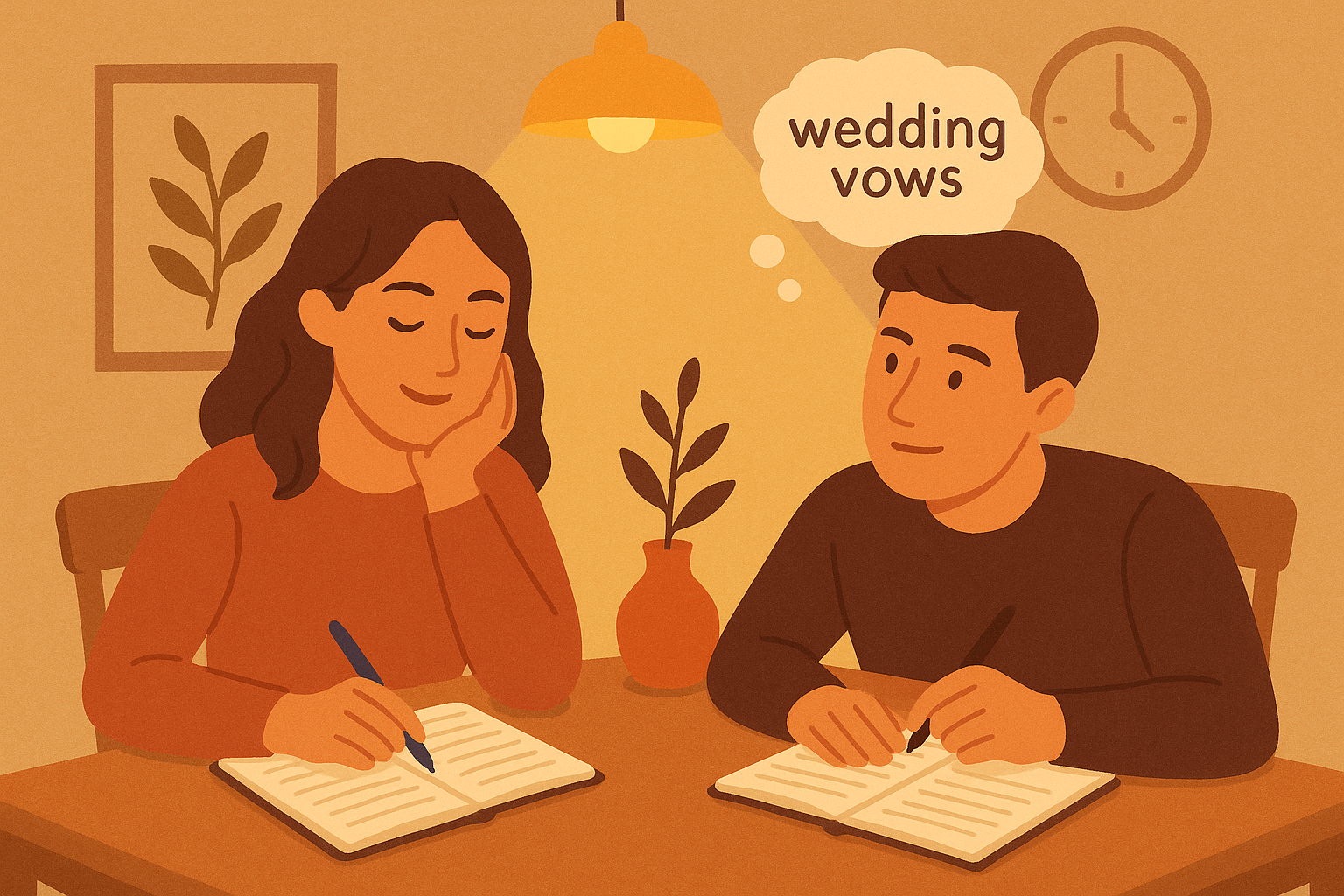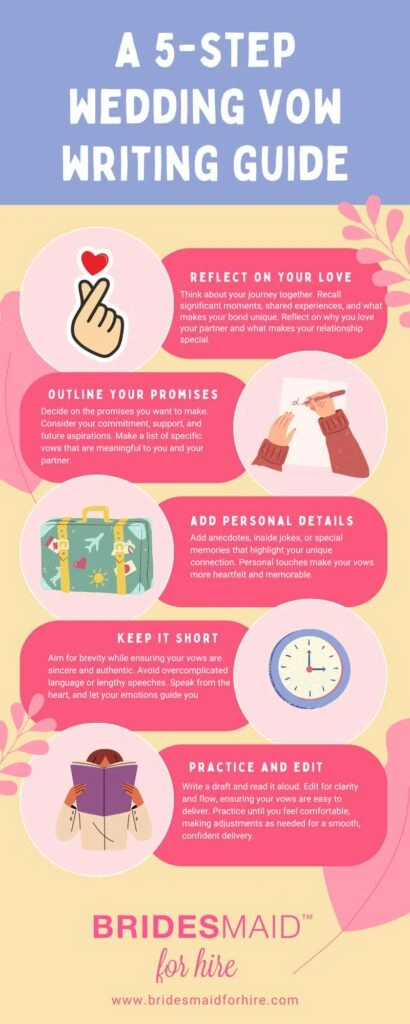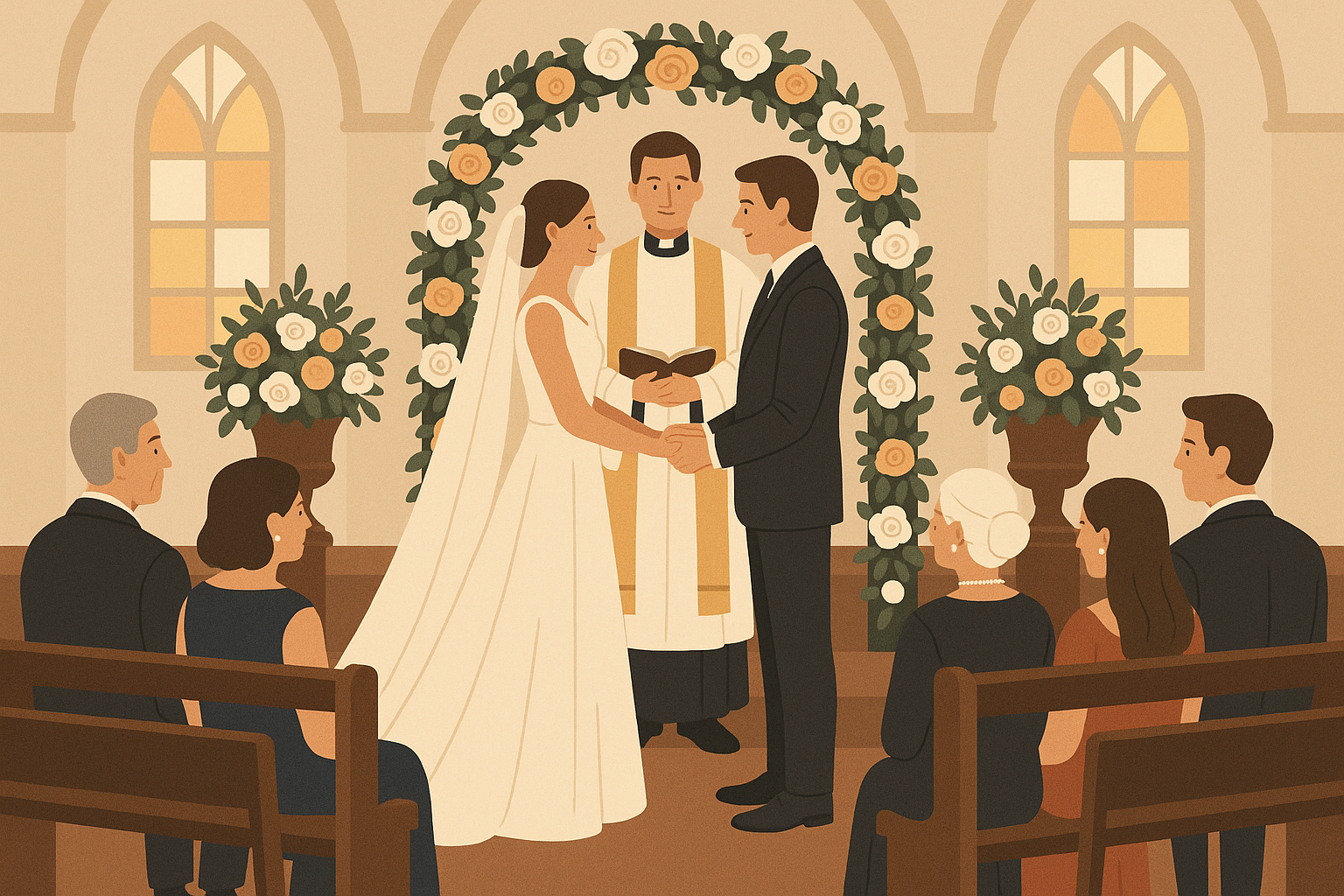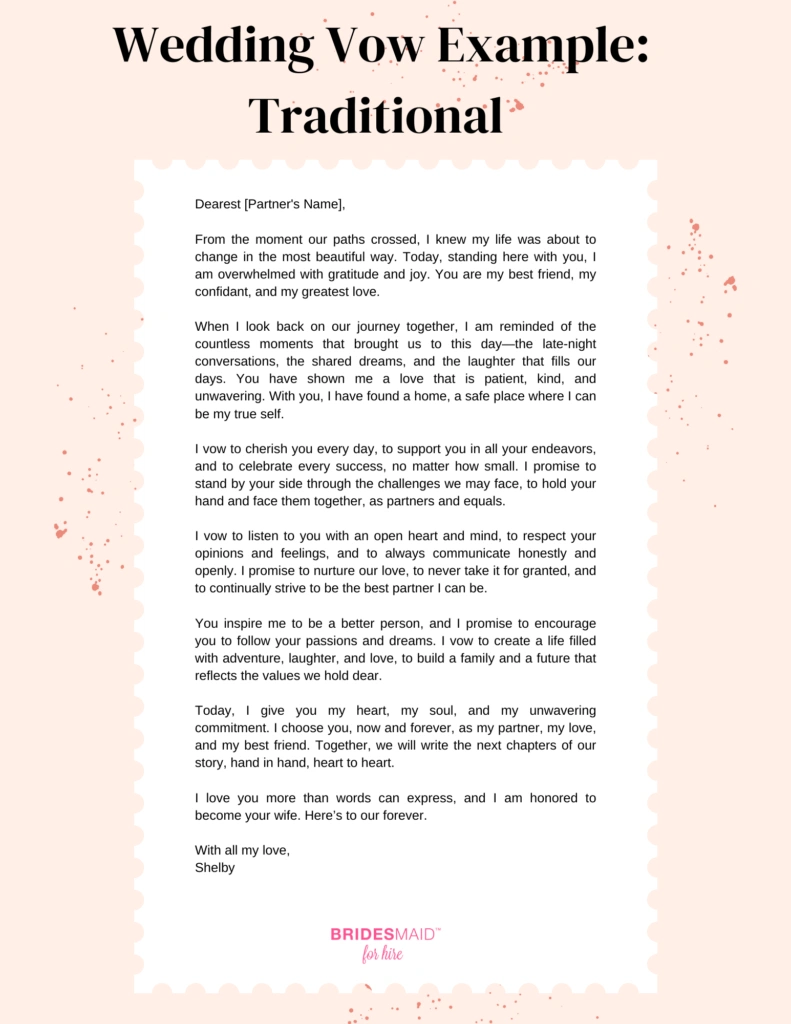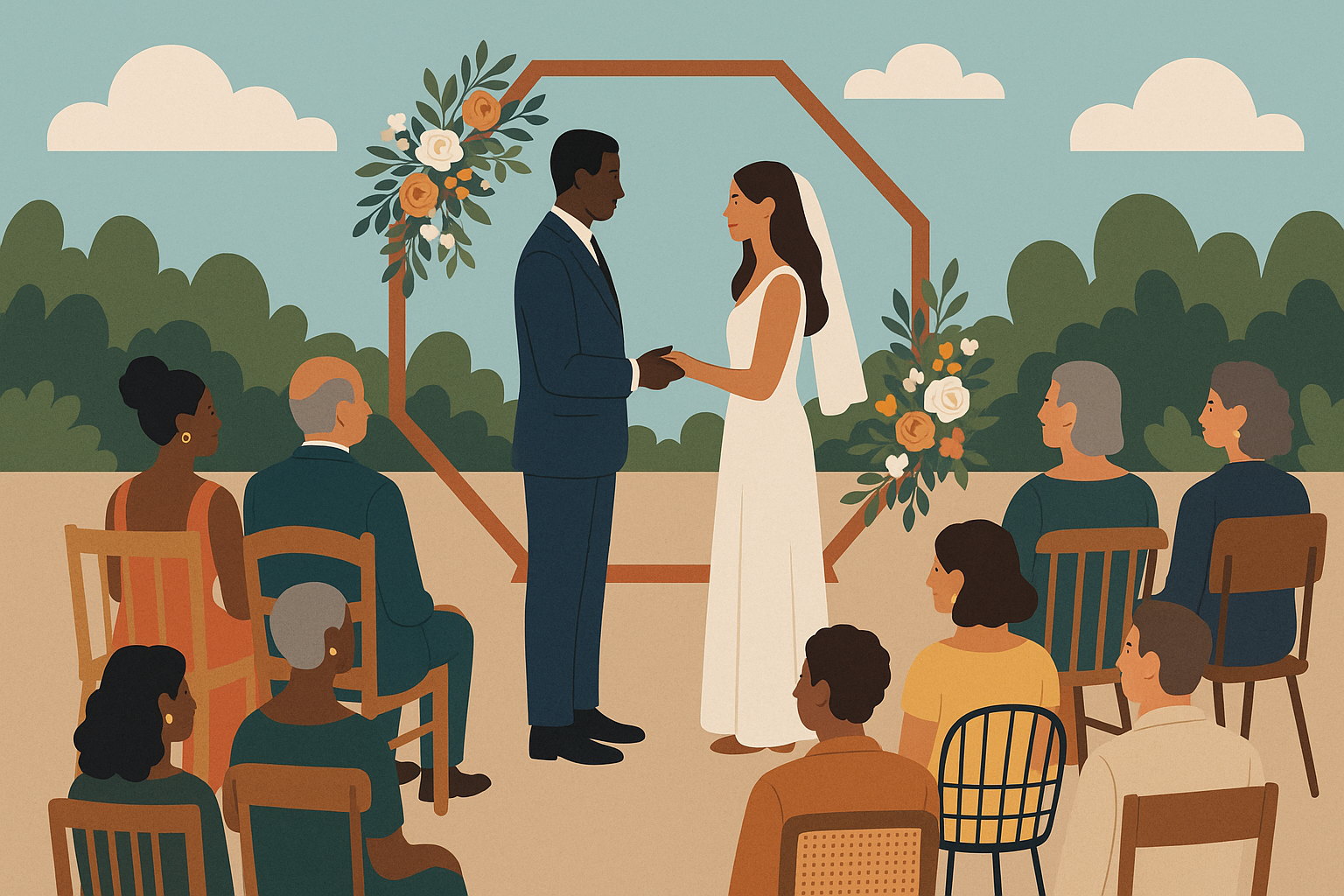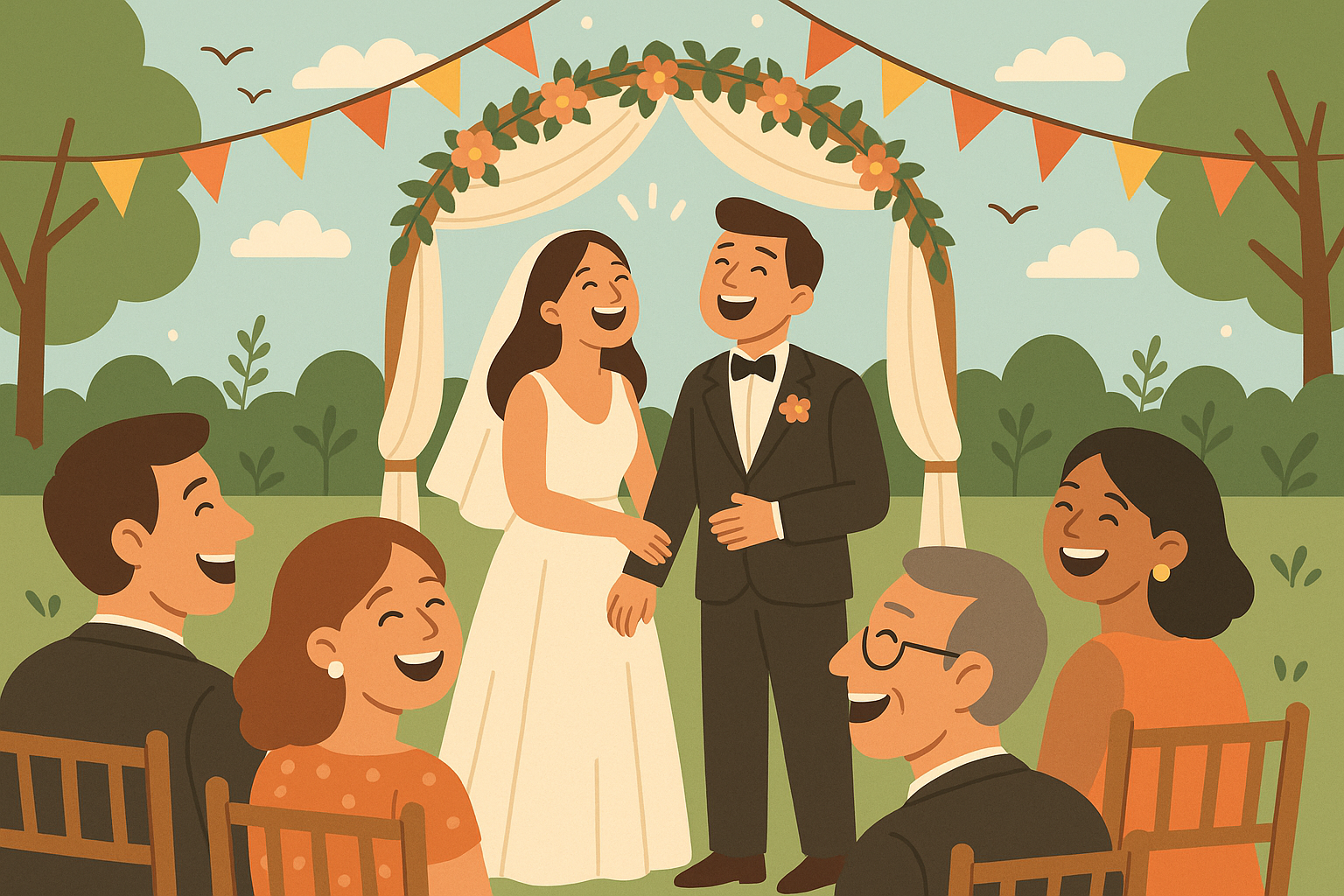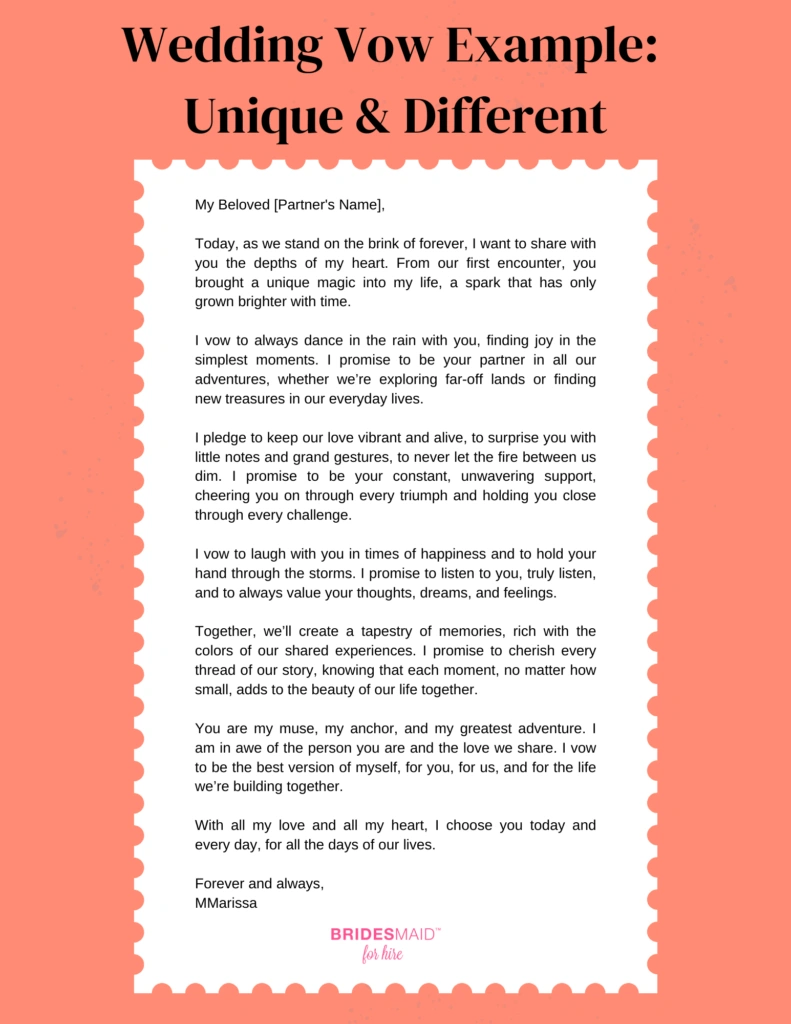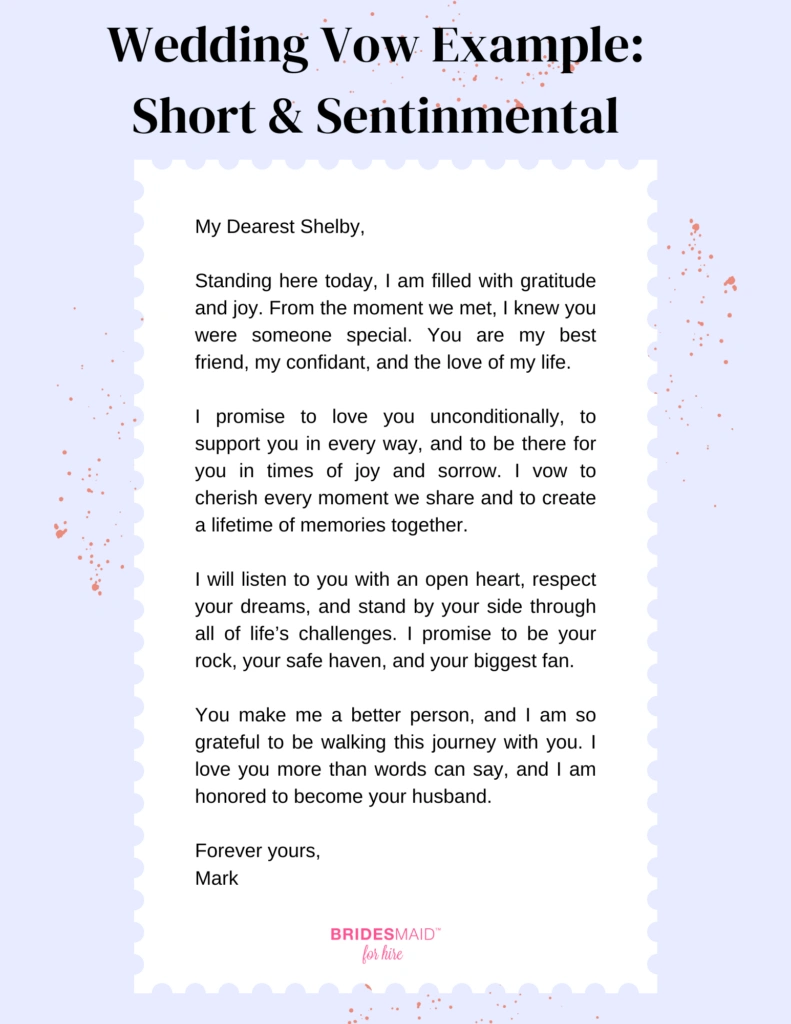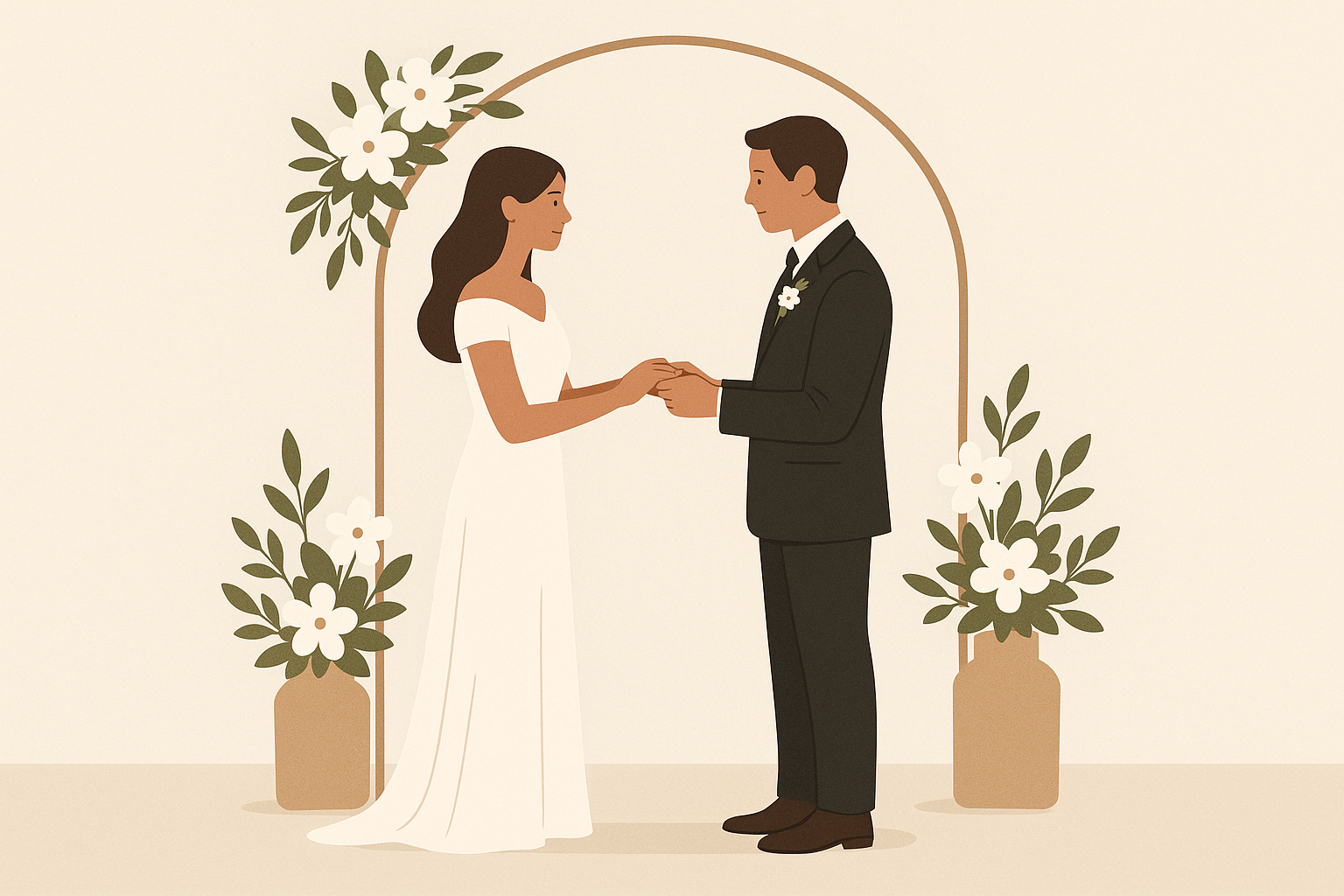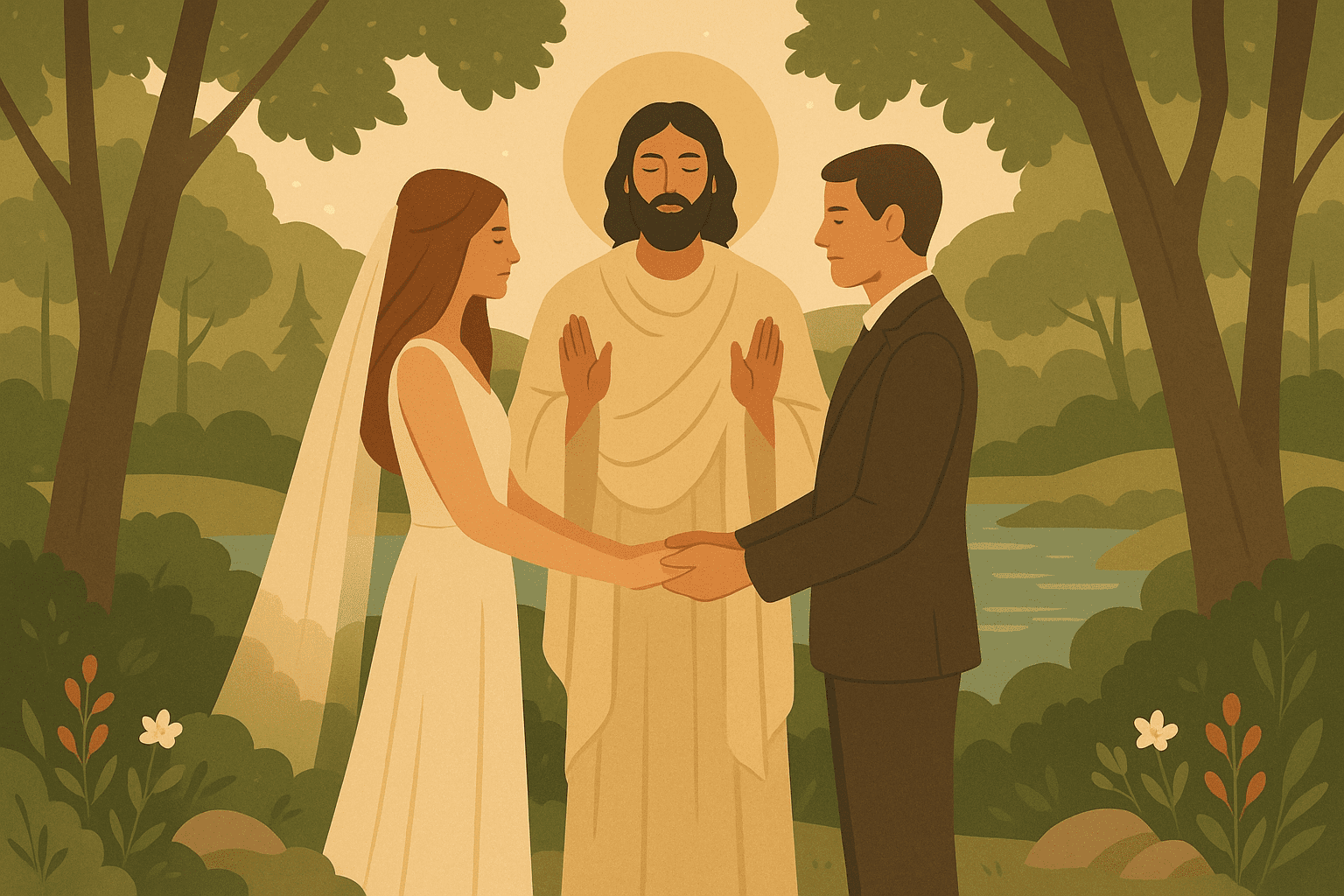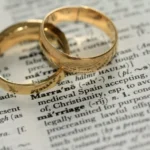Hi, Friend! Jen Glantz here. I’m a bestselling author, the first ever bridesmaid for hire and have written over 1000 wedding vows for couples all around the world! Let’s talk check out some wedding vow examples to inspire your own.
Quick Resources:
-
Create custom vows with our Wedding Vow Generator
-
Get inspired with our AI Love Letter Generator
-
Nervous about your speech? Use our AI Wedding Speech Generator
-
Need more help? Explore All Wedding Tools
Okay, let’s be honest – writing your own wedding vows is terrifying. You’re sitting there with a blank document, cursor blinking, thinking “How the heck do I sum up my entire relationship in two minutes without ugly crying?” I’ve been to countless weddings where some couples delivered heartfelt promises that left everyone in tears, while others stumbled through generic words that sounded like they came straight from a greeting card.
Here’s the thing nobody tells you about wedding vows – they don’t have to be perfect to be meaningful. Your vows deserve better than cookie-cutter phrases you found on Pinterest at 2 AM. They should sound like you actually talking to your person, whether you communicate through inside jokes, shared adventures, or those quiet moments when you’re both just trying to figure out whose turn it is to do the dishes.
The good news? You don’t need to be Shakespeare to create vows that’ll make your guests ugly cry in the best way possible. This guide breaks down 25 handpicked wedding vows across six different styles, helping you navigate one of your biggest wedding decisions without losing your mind. From traditional religious ceremonies to modern partnerships, funny exchanges to deeply personal promises, you’ll find words that actually fit your relationship – plus all the real talk about what makes vows actually work.
Write your own with ease using our Wedding Vow Generator
Things You Actually Need to Think About Before Writing Your Vows
Before we dive into the good stuff, let’s talk about the practical things that’ll save you from a wedding day disaster. Trust me, you want to figure these out before you start writing, not the night before your wedding when you’re having a breakdown about whether your vows are “good enough.”
Writing wedding vows isn’t about finding pretty words – it’s about matching your actual voice with your ceremony’s vibe and your guests’ expectations. Your natural communication style matters way more than you think. Are you the type who gets emotional easily, or do you need structure to feel confident? Some people can speak from the heart on the spot, while others need every word planned out to avoid turning into a blubbering mess in front of Great Aunt Martha.
The setting and audience matter way more than you might think. An intimate backyard gathering of twenty close friends? That’s the perfect place for deeply personal stories that might make your conservative in-laws uncomfortable at a formal church ceremony with 200 guests. Think about who’s actually going to be listening – are these your college friends who know all your embarrassing stories, or a mixed crowd including your partner’s boss and your grandmother who still thinks you’re “living in sin”?
Your relationship’s unique dynamic should absolutely shine through your vows. Are you the couple that bonds over terrible reality TV and shared takeout? Do you communicate primarily through memes and playful roasting? Maybe your connection is all about shared values and that volunteer work you do together. Your wedding vows should sound like you actually talking to each other, not like you’re auditioning for a Nicholas Sparks movie.
| Vow Style | Best For | Ceremony Type | Guest Considerations |
|---|---|---|---|
| Traditional | Religious couples, formal ceremonies | Church, synagogue, mosque | Mixed ages, conservative families |
| Modern | Contemporary couples, equality-focused | Outdoor, non-religious venues | Younger crowds, progressive families |
| Humorous | Playful couples, entertainers | Casual settings, close friends | Intimate gatherings, like-minded guests |
| Personal | Intimate couples, storytellers | Any setting | Close family and friends |
| Short | Nervous speakers, minimalists | Any ceremony type | Any audience size |
| Spiritual | Nature-loving, spiritual couples | Outdoor, alternative venues | Open-minded, diverse groups |
Start writing heartfelt vows with our free AI Love Letter Generator
Let’s get real about the practical stuff too. How comfortable are you with public speaking? Does your partner have the attention span of a goldfish, or do they love detailed storytelling? Some couples work best with brief, punchy statements that pack emotional punch into just a few sentences. Others need the full three-minute epic to feel like they’ve said everything.
Here’s something crucial: coordinate with your partner without making it weird. You don’t need matching vows (honestly, that might be kind of creepy), but you should discuss your general approach. Nobody wants to follow their partner’s heartfelt three-minute love letter with thirty seconds of “uh, what they said, but ditto.” Talk about length, tone, and whether you’re going funny or sentimental – just don’t share your actual words if you want to keep some surprise.
Finally, check if there are any rules you need to follow. Some ceremonies require specific traditional elements or language, while others let you do whatever you want. Figure this out early so you don’t write beautiful personal vows only to discover they don’t fit your ceremony’s requirements. Trust me, that conversation with your officiant is way better to have now than two days before your wedding.
Traditional Wedding Vows That Stand the Test of Time
Look, maybe you grew up thinking you’d have a church wedding with all the classic “for better or worse” language. That’s totally fine! These words have been making people cry happy tears for centuries for a reason. Traditional vows offer the security of time-tested language that your grandmother will recognize and your nervous cousin can follow along with easily.
1. Classic Christian Vows
These are the OG wedding vows – the ones your parents probably used, and their parents before them. They’re formal, they’re sacred, and they connect you to generations of married couples who’ve made the same promises.
“I, [name], take you, [name], to be my wedded [husband/wife], to have and to hold from this day forward, for better, for worse, for richer, for poorer, in sickness and in health, to love and to cherish, till death us do part, according to God’s holy ordinance; and thereto I pledge you my faith.”
These classic wedding vows are perfect if you have deep religious convictions and want your ceremony to reflect your faith. The formal structure is great for nervous speakers because you don’t have to think – you just follow the script. But heads up: the religious references and old-school language might feel a bit stiff if you’re more of a “let’s grab tacos and binge Netflix” couple.
Make your spiritual vows meaningful with help from our Wedding Vow Generator
2. Traditional Civil Vows
All the dignity and structure of traditional promises, but without the religious stuff. Perfect if you want conventional language that everyone understands, regardless of what they believe about the Big Guy upstairs.
“I, [name], take you, [name], to be my [husband/wife]. I promise to be true to you in good times and in bad, in sickness and in health. I will love you and honor you all the days of my life.”
The beauty of civil marriage vows is that literally everyone gets them. Your atheist college roommate and your devoutly religious aunt can both nod along approvingly. They work anywhere – from courthouse ceremonies to elaborate destination weddings – and they provide structure without making anyone uncomfortable about their personal beliefs.
3. Modified Traditional Vows
These are like traditional vows that went to therapy and learned to communicate better. You get the gravitas of classic promises with room for modern relationship dynamics and personal expression.
“I, [name], choose you, [name], to be my partner in life. I promise to love, honor, and respect you; to comfort and encourage you; to be faithful to you; and to share my life openly with you, through all the changes of our lives, as long as we both shall live.”
Modified traditional marriage vows solve that problem where you respect tradition but also want your ceremony to reflect that you’re equal partners who split the mortgage. The word “choose” emphasizes that you’re here voluntarily (revolutionary concept!), while “partner” suggests you’re teammates rather than following some 1950s playbook. You keep the ceremonial dignity while actually sounding like people who live in the 21st century.
Sarah and Michael’s Modified Traditional Approach: This couple wanted traditional structure but modern language that didn’t make them cringe. Sarah, a teacher, loved explaining their choices: “We chose ‘partner’ instead of ‘husband and wife’ because we see ourselves as equals building a life together. We kept ‘as long as we both shall live’ because that commitment feels sacred to us, but we added ‘through all the changes’ because we know we’ll both grow and evolve.” Their families got the familiar structure while understanding the couple’s values.
4. Interfaith Traditional Vows
When you want the formality of traditional promises but need to keep things inclusive for your diverse crowd, these vows focus on universal human experiences that everyone can relate to.
“I, [name], take you, [name], as my beloved [husband/wife]. I promise to walk beside you through all of life’s adventures, to support your dreams, to comfort you in times of sorrow, and to celebrate with you in times of joy, for all the days of our lives.”
These traditional wedding vows focus on stuff everyone understands – adventure, dreams, sorrow, joy – without getting into specific religious territory. They maintain that formal ceremony feel while making sure nobody feels left out because they don’t share your particular beliefs about the afterlife.
Modern Wedding Vows for Contemporary Couples
Maybe you’re the couple that splits everything 50/50, from mortgage payments to who takes out the trash. Your vows should sound like that too. Modern vows reflect how relationships actually work when both people have careers, opinions, and equal say in whether you’re having pizza or sushi for dinner.
5. Partnership-Focused Modern Vows
These vows are for couples who reject the whole “taking” someone as your spouse thing and prefer the idea of choosing each other as teammates in this weird adventure called life.
“[Name], today I choose you as my life partner. I promise to be your biggest supporter, your closest friend, and your most devoted companion. I vow to grow with you, to challenge you, and to be challenged by you. I promise to love you for who you are today, but also for who you’re still becoming.”
Partnership-focused modern wedding vows are perfect if you’ve built your relationship on equality and mutual respect. They work especially well for couples who’ve already been living together, splitting bills, and making major life decisions as a team. The language emphasizes that you’re choosing each other every day, not just “taking” someone like they’re a prize you won.
Write your own with ease using our Wedding Vow Generator
6. Adventure-Based Modern Vows
For couples who bond over shared experiences and future plans, these vows frame marriage as an exciting journey of discovery rather than just a legal contract to split household chores.
“[Name], I promise to be your co-pilot in this adventure called life. I vow to explore the world with you, to try new things together, to support your wildest dreams, and to create a lifetime of memories. I promise to love you through every plot twist our story brings.”
Adventure-based wedding vows are great if you’re known for your travel photos, outdoor activities, or general willingness to try that weird new restaurant everyone’s talking about. They work beautifully for destination weddings or couples whose relationship story includes significant shared adventures. Just remember, they might not address the deeper “I’ll love you when you’re sick and cranky” commitment aspects that some couples want to emphasize.
7. Equality-Focused Modern Vows
These vows explicitly address modern values and make it clear that you’re equals in this partnership, perfect for couples who want their ceremony to reflect progressive values.
“[Name], I stand here as your equal, ready to build a life of mutual respect and shared dreams. I promise to support your ambitions as much as my own, to share in both the work and the joy of our partnership, and to love you as both an individual and as part of our team.”
Equality-focused modern wedding vows work well for couples where both partners have strong career ambitions, couples who’ve had serious conversations about sharing domestic responsibilities, or those who want their ceremony to make a statement about their values. Fair warning: they might feel too political for some family dynamics, but they powerfully express what modern relationships can look like.
8. Growth-Oriented Modern Vows
These vows acknowledge that people change over time and promise to love through personal evolution – perfect for couples who understand that successful relationships require adapting to each other’s growth.
“[Name], I promise to love all the versions of you – who you were when we met, who you are today, and who you’re becoming. I vow to grow alongside you, to learn from you, and to support your evolution as a person while staying true to myself.”
Growth-oriented wedding vows are beautiful for couples who’ve experienced significant personal development during their relationship or who understand that successful marriages require adapting to change. They’re especially meaningful for couples who met young and have grown up together, or those who’ve supported each other through career changes, education, or personal challenges.
9. Minimalist Modern Vows
These stripped-down vows cut straight to the essential commitment without elaborate language – perfect for couples who prefer actions over words or hate long speeches.
“[Name], I choose you. Today, tomorrow, and every day after. I promise to love you, support you, and stand by you. You are my person, and I am yours.”
Minimalist modern wedding vows work beautifully for couples who communicate more through actions than words, those who get emotional easily and prefer brevity, or couples having very intimate ceremonies where elaborate speeches might feel out of place. Some might find them too brief for such a big moment, but their simplicity can be incredibly powerful.
Humorous Wedding Vows That Celebrate Your Personality
If you’re the couple that communicates through inside jokes and playful roasting, your vows should reflect that. Humorous vows let you showcase your actual relationship dynamic while still expressing genuine commitment – just with more laughs and fewer dramatic pauses.
10. Self-Deprecating Humor Vows
These vows use gentle self-mockery and realistic relationship observations to create laughter while expressing deep love. Perfect for couples who aren’t afraid to acknowledge their flaws and find humor in everyday relationship stuff.
“[Name], I promise to love you even when I’m hangry, even when you leave dishes in the sink, and even when you inevitably realize you could have done better. I vow to laugh at your jokes, even the bad ones, and to pretend you’re funnier than me, even though we both know the truth.”
Self-deprecating humor works wonderfully if you’re known among friends and family for your realistic approach to relationships and your ability to laugh at yourselves. These humorous wedding vows can lighten the mood and make guests feel more connected to your authentic dynamic, though they might not land well with more traditional attendees who expect serious ceremony vibes.
Jake and Emma’s Comedy Balance: This couple met doing improv comedy, so humor was essential to their vows. Jake started with: “Emma, I promise to always laugh at your jokes, even when they’re not funny—which, let’s be honest, is most of the time.” But he followed with genuine emotion: “But seriously, you make even the ordinary moments feel exciting, and I can’t wait to spend forever laughing with you.” The combination kept guests engaged while honoring their authentic relationship dynamic.
11. Pop Culture Reference Vows
These vows incorporate shared cultural touchstones and favorite entertainment references to create instant connection with guests while showcasing what you actually bond over in real life.
“[Name], you are the Jim to my Pam, the Leslie to my Ben, the [insert your favorite couple reference]. I promise to love you more than coffee (and that’s saying something), to binge-watch terrible shows with you, and to always share my fries – well, most of them.”
Pop culture vows create memorable moments and show guests what you actually talk about when you’re alone together. They work especially well for couples whose relationship revolves around shared entertainment preferences or who bonded over common fandoms. Just remember that references might exclude guests who don’t get them, and they could feel dated in a few years.
12. Quirky Promise Vows
These vows focus on small, daily aspects of love that often matter most in real relationships, highlighting the charming and mundane promises that actually make marriages work.
“[Name], I promise to always pretend to be asleep when it’s your turn to let the dog out at 3 AM. I vow to support your weird hobbies, to laugh at your dad jokes, and to never judge you for eating cereal for dinner. I promise to love your morning hair and to always save you the last slice of pizza.”
Quirky promises resonate because they address the reality of daily married life rather than grand romantic gestures. They’re charming and relatable, showing guests that you understand what marriage actually involves – like who’s dealing with the dog’s 3 AM bathroom emergencies and who gets the last slice of pizza.
13. Playfully Realistic Vows
These vows acknowledge relationship challenges with humor while expressing unwavering commitment – perfect for couples who communicate through playful teasing and understand that marriage requires work.
“[Name], I promise to love you even when you steal the covers, leave the toilet seat up, or insist on watching that show I hate. I vow to be your partner in crime, your alibi when needed, and your biggest fan – even when you’re being ridiculous.”
Playfully realistic vows work well for couples who’ve lived together and experienced each other’s annoying habits but choose to find them endearing rather than deal-breakers. They show maturity about marriage while maintaining your humorous communication style.
Write your own with ease using our Wedding Vow Generator
Deeply Personal Wedding Vows That Tell Your Story
Personal wedding vows create intimate connections by incorporating specific memories, shared values, and unique relationship elements that only apply to your partnership. These vows help you express what makes your love story special while making meaningful promises that reflect your individual journey together.
14. Memory-Based Personal Vows
These vows weave specific shared experiences and meaningful moments into promises for the future, creating emotional resonance by connecting past memories with future commitments in ways that help guests understand your unique story.
“[Name], from our first [specific memory] to this moment, you’ve been my constant source of joy. I promise to never forget the way you [specific trait], to always support your [specific dream/passion], and to love you through every season of our lives. You’ve taught me that love isn’t just a feeling – it’s a choice I make every day, and I choose you.”
Memory-based vows require significant preparation but create deeply meaningful moments that guests remember long after the ceremony. They work best when you can identify specific moments that defined your relationship and translate those into future promises. Just be careful not to get so personal that your guests feel like they’re eavesdropping on a private conversation.
| Personal Vow Element | How to Include | Example | Impact Level |
|---|---|---|---|
| First meeting story | Brief 1-2 sentence reference | “From that rainy Tuesday at the coffee shop…” | High emotional connection |
| Shared challenges overcome | Acknowledge growth together | “When we survived your job loss…” | Shows resilience |
| Partner’s unique traits | Specific, loving observations | “Your way of humming while cooking…” | Intimate and authentic |
| Future dreams | Concrete shared goals | “Building our dream home in Colorado…” | Forward-looking hope |
| Daily love expressions | Small, meaningful gestures | “How you leave notes in my lunch…” | Relatable and sweet |
15. Values-Driven Personal Vows
These vows center around shared principles and causes that define your relationship, perfect for partners whose connection is built around common beliefs, social causes, or life philosophies that guide your decisions together.
“[Name], you’ve shown me what it means to live with integrity, compassion, and purpose. I promise to honor the values we share, to support the causes you care about, and to build a life that reflects our commitment to making the world better. I vow to be worthy of your love and to love you with the same depth you’ve shown me.”
Values-driven vows work exceptionally well for couples whose relationship centers around shared principles, volunteer work, or causes you care about together. They create meaningful commitment beyond just romantic feelings, though you’ll want to avoid sounding preachy or overly serious.
16. Future-Focused Personal Vows
These vows express excitement about shared goals and dreams while making specific promises about supporting each other’s aspirations – perfect for couples who spend significant time planning your future together.
“[Name], I can’t wait to see what our future holds. I promise to dream big dreams with you, to work toward our shared goals, and to support you in achieving everything you want in life. I vow to be your safe harbor in storms and your biggest cheerleader in victories.”
Future-focused vows inspire hope and excitement while making concrete promises about ongoing support. They work well for couples with clear shared goals or individual ambitions you want to pursue together. Just remember that some people prefer promises about constant love regardless of circumstances rather than future-dependent commitments.
17. Gratitude-Based Personal Vows
These vows focus on appreciation for your partner and relationship while making promises based on thankfulness, creating positive emotional impact by acknowledging specific ways your partner has enriched your life.
“[Name], thank you for seeing me – really seeing me – and loving what you found. Thank you for your patience with my flaws, your celebration of my strengths, and your unwavering belief in our love. I promise to never take your love for granted and to show you every day how grateful I am to be yours.”
Gratitude-based vows create emotionally powerful moments by focusing on appreciation rather than just promises. They work beautifully for couples who’ve supported each other through difficult times or who want to acknowledge how your partner has changed your life for the better.
18. Challenge-Focused Personal Vows
These vows acknowledge that love involves growth and difficulty while promising to face challenges together – perfect for couples who’ve already weathered significant obstacles or who want to express mature understanding of marriage’s complexities.
“[Name], loving you has made me braver, kinder, and stronger. I promise to continue growing into the person you see in me, to challenge you to be your best self, and to face whatever challenges come our way as a united team. I vow to love you through our differences, because of them.”
Challenge-focused vows demonstrate mature understanding of marriage while expressing commitment to growth and teamwork. They work well for couples who’ve overcome obstacles together or who want to acknowledge that successful relationships require ongoing effort and adaptation.
Maria and David’s Challenge-Focused Approach: After surviving a long-distance relationship during medical school, this couple wanted vows that acknowledged their proven ability to overcome difficulties. Maria said: “David, we’ve already proven that love isn’t about the easy moments—it’s about choosing each other when everything else feels impossible. I promise to keep choosing you, especially when it’s hard.” Their vows resonated deeply with guests who knew their story and showed their mature understanding of marriage.
Short and Simple Wedding Vows for Minimalists
Sometimes less really is more. Short wedding vows distill essential commitments into powerful, concise statements that pack emotional punch without requiring a novel. Perfect for couples who get emotional easily, prefer simplicity, or just want maximum impact with minimal words.
19. Classic Short Vows
These brief vows capture traditional commitment elements in essential language – perfect for couples who want conventional promises without lengthy speeches or who feel nervous about public speaking.
“[Name], I love you. I choose you. I promise to honor you, support you, and cherish you for all the days of my life.”
Classic short wedding vows work perfectly for couples who get emotional during public speaking or who prefer actions over elaborate words. They’re universally appropriate and memorable despite their brevity, though some couples might find them too brief for such an important moment.
20. Promise-Based Short Vows
These concise vows focus on specific commitments using minimal language, creating clear and memorable promises that guests can easily follow and remember.
“[Name], I promise to love you, laugh with you, and grow old with you. You are my heart, my home, and my forever.”
Promise-based simple wedding vows work well for couples who want to make specific commitments without elaborate explanations. They’re emotionally impactful and easy to remember, making them perfect for nervous speakers or intimate ceremonies where lengthy vows might feel out of place.
21. Declaration Short Vows
These brief vows state the relationship’s significance simply and powerfully, focusing on declaring love and commitment rather than making detailed promises.
“[Name], you are my best friend, my greatest love, and my chosen family. I am yours, completely and forever.”
Declaration simple wedding vows create powerful emotional moments through simple statements of love and belonging. They work beautifully for couples who communicate more through feelings than specific promises, though they might not satisfy couples wanting to address particular aspects of their relationship.
22. Simple Commitment Vows
These minimal vows express acceptance and dedication without elaborate language, focusing on the fundamental choice to love and commit while acknowledging the ongoing nature of that decision.
“[Name], I take you as you are, and I promise to love you as you become. Today and always.”
Simple commitment vows are beautiful in their straightforward honesty about accepting someone completely. They work well for couples who’ve been together long enough to truly know each other’s flaws and strengths, though they might feel incomplete to couples wanting more detailed relationship promises.
Culturally-Inspired and Spiritual Wedding Vows
Spiritual and culturally-inspired wedding vows incorporate elements from nature, universal spirituality, and gratitude themes to create meaningful ceremonies for couples with shared beliefs or connections to something greater than yourselves.
23. Nature-Inspired Spiritual Vows
These vows use natural elements and seasonal imagery to express eternal commitment – perfect for couples who feel connected to nature, are having outdoor ceremonies, or want to incorporate earth-based spirituality into your promises.
“[Name], like the mountains and the sea, the changing seasons and the constant stars, I promise to love you through all of life’s changes and constants. I vow to grow with you like intertwined trees, supporting each other as we reach toward the light.”
Nature-inspired vows work beautifully for outdoor ceremonies or couples who bond over hiking, gardening, or environmental causes. They create poetic imagery that many guests find moving, though they might feel too abstract for couples preferring concrete promises.
24. Unity-Focused Spiritual Vows
These vows emphasize the spiritual connection between partners and the sacred nature of your bond – ideal for couples with shared spiritual beliefs who want your ceremony to reflect your understanding of marriage as a spiritual union.
“[Name], I believe that our souls were meant to find each other. I promise to honor the sacred bond between us, to nurture our spiritual connection, and to walk this earthly journey hand in hand, heart to heart, spirit to spirit.”
Unity-focused spiritual vows resonate deeply with couples who share spiritual beliefs or who see your relationship as divinely guided. They create meaningful ceremony moments for like-minded guests but might not connect with more secular attendees.
25. Gratitude-Centered Spiritual Vows
These vows combine thankfulness with spiritual commitment, acknowledging forces beyond the couple that brought you together while making promises to treat your love as a sacred gift.
“[Name], I am grateful to the universe, to fate, to God, for bringing you into my life. I promise to treat our love as the sacred gift it is, to honor you as my spiritual partner, and to create a life together filled with purpose, compassion, and joy.”
Gratitude-centered spiritual vows work well for couples who feel your meeting was meant to be or who want to acknowledge something greater than yourselves in your ceremony. They’re positive and meaningful but require both partners to be comfortable with spiritual language.
What Actually Makes Wedding Vows Work
Here’s the real talk about what makes wedding vows memorable and meaningful, regardless of whether you go traditional, modern, funny, or deeply personal. Understanding these elements helps you craft or choose vows that’ll actually resonate with your audience while authentically expressing your commitment.
The most impactful wedding vows balance several key things that work together to create those memorable moments everyone talks about afterward. Authenticity tops the list – your vows should sound like you actually talking, not like you’re reading someone else’s words or auditioning for a rom-com. Guests can totally tell when vows feel genuine versus when you’re trying too hard to sound “wedding-appropriate.”
Specificity makes wedding vows memorable and personal. Instead of saying “I love your kindness,” try “I love how you always check on our elderly neighbors during snowstorms.” Specific details help guests understand your unique relationship while making your promises feel real rather than generic.
Length matters more than you might think. Can we talk about length for a hot second? Your Great Aunt Martha has been sitting in uncomfortable shoes for an hour. Great wedding vows should be long enough to feel meaningful but short enough to hold everyone’s attention. Generally, aim for one to three minutes when spoken aloud – and practice reading your vows out loud multiple times to get the timing right.
| Vow Length | Speaking Time | Best For | Potential Challenges |
|---|---|---|---|
| 50-75 words | 30-45 seconds | Nervous speakers, minimalists | May feel too brief |
| 100-150 words | 1-1.5 minutes | Most couples, balanced approach | Requires careful word choice |
| 200-300 words | 2-3 minutes | Storytellers, detailed couples | Risk losing audience attention |
| 300+ words | 3+ minutes | Very personal ceremonies | May overwhelm guests |
Choose vows that fit your timing and tone with our Wedding Vow Generator
Balance creates the most effective wedding vows. You want to blend emotion with commitment, present appreciation with future promises, and personal details with universal themes that guests can relate to. The best vows make guests feel included in your love story while maintaining intimacy between you and your partner.
Clear delivery can make or break even the most beautifully written vows. Practice reading aloud until you’re comfortable with the words and pacing. Pro tip: write in larger font, use shorter sentences, and mark places to pause for breath or emotion. And for the love of all that’s holy, write your vows on index cards, not your phone – you don’t want to deal with a dead battery at the altar.
Coordination with your partner prevents awkward mismatches without requiring identical approaches. Maybe give each other a heads up if you’re planning to go super emotional or crack jokes. Nobody wants to follow a tear-jerker with a stand-up routine. Discuss general length, tone, and level of personal detail beforehand. You don’t need matching vows, but they should complement each other rather than creating jarring contrasts.
Understanding what wedding vows actually are at their core – promises of love, commitment, and partnership – helps you focus on what truly matters rather than getting caught up in perfect wording or elaborate metaphors.
How Professional Support Can Transform Your Vow Writing Experience
Look, writing wedding vows can feel overwhelming when you’re already juggling a million wedding decisions and trying to keep both families happy. Professional vow writing services offer objective perspective, emotional support, and practical expertise that transforms this stressful task into a meaningful part of your wedding planning journey instead of another thing keeping you up at 3 AM.
Many couples find themselves completely paralyzed by the pressure to create “perfect” vows that capture their entire relationship in just a few minutes. This pressure often reveals deeper anxieties about wedding planning itself – the weight of family expectations, the desire to create a meaningful ceremony, and the challenge of expressing something as complex as love in front of everyone you know.
Professional vow writing services address these challenges by providing objective perspective when you’re drowning in opinions from family, friends, and other wedding vendors. A professional can help you cut through conflicting advice and focus on what truly matters to you as a couple, rather than what others think your wedding vows should sound like.
The emotional support aspect often surprises couples. Writing your own wedding vows can bring up unexpected feelings about your relationship, your future, and even your past. Having a trained professional to process these emotions with – someone who isn’t emotionally invested in the outcome – provides the safe space many couples need during this vulnerable process.
Practical expertise makes a significant difference in both writing and delivery. Professionals understand the logistics of vow delivery, from managing nerves to handling papers in windy outdoor ceremonies. They’ve seen every possible vow style and audience reaction, giving them insight into what works for different personality types and ceremony styles.
For couples seeking comprehensive wedding support, exploring professional wedding coaching services can provide guidance beyond just vow writing to ensure your entire ceremony reflects your authentic relationship.
Bridesmaid for Hire’s personalized wedding vow writing services take this support even further. Having attended over 150 weddings, their team understands how different vow styles work in various settings and with different audiences. They can help you navigate the considerations outlined throughout this guide while ensuring your final vows authentically reflect your relationship. Beyond writing assistance, they offer public speaking coaching to help you deliver your vows with confidence. Many couples write beautiful words but struggle with the actual delivery on their wedding day. Professional coaching helps you practice, manage nerves, and ensure your carefully crafted promises actually get heard by your guests.
Get vow-writing coaching and delivery support with our Wedding Vow Generator
Perhaps most importantly, professional support provides the unbiased guidance you need when making deeply personal decisions. While friends and family mean well, they often have their own opinions about what your vows should sound like. A professional bridesmaid helps you stay true to your authentic voice while ensuring your vows are appropriate for your specific ceremony and audience.
Whether you need help brainstorming ideas, refining your draft, or simply having someone to bounce thoughts off of, professional vow writing support transforms an overwhelming task into a manageable, meaningful part of your wedding planning process. Because ultimately, your vows should tell your love story – and professional support helps ensure you tell it beautifully.
Final Thoughts
Listen, your wedding vows represent one of the most important speeches you’ll ever give, but they don’t have to be perfect to be meaningful. The most memorable vows are those that authentically reflect your relationship, whether that’s through traditional promises, modern partnerships, shared humor, or deeply personal memories.
Remember that there’s no single “right” way to express your commitment. Some couples thrive with elaborate, detailed promises that tell their entire love story, while others find power in simple declarations that cut straight to the heart of their bond. What matters most is choosing words that feel true to who you are as individuals and as a couple.
The process of writing or selecting your vows should bring you closer together, rather than create additional stress during an already overwhelming time. Take time to discuss your preferences with your partner, consider your audience and setting, and don’t be afraid to seek professional help if you’re feeling stuck or overwhelmed.
Whether you choose traditional vows that connect you to generations of married couples, modern promises that reflect contemporary values, or something completely unique to your relationship, your wedding day vows will become part of your marriage story. Years from now, you’ll remember the words you spoke, but also the feeling of standing before your loved ones and making those promises to each other.
And hey, if all else fails, just remember: in 20 years, you probably won’t remember exactly what you said anyway. But you’ll remember how it felt to promise forever to your favorite person. Trust yourself, be authentic, and remember that the most important audience for your vows is standing right across from you, ready to promise their own love and commitment in return.
Your person is marrying you because they want YOU – not some perfect version that exists only in romantic comedies. So be yourself, speak from your heart, and try not to overthink it. You’ve got this.
1-800-BRIDESMAID
The Newlywed
Card Game
something extra to love
Read the weekly newsletter from Bridesmaid for Hire, 1-800-Bridesmaid, to hear about real stories, from strangers, who need advice on love, life, friendship, and so much more.
Looking for the perfect wedding gift for someone you adore? Grab The Newlywed Card Game. It's a fun and interactive game they can play on their honeymoon or future date nights.

